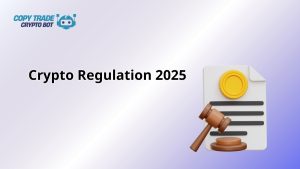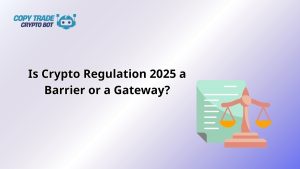Table of Contents
- 1 Crypto Regulation 2025 Is Redefining the Market
- 2 The Global Evolution of Crypto Regulation in 2025
- 3 Regional Trends in Crypto Regulation 2025
- 4 Implications of Crypto Regulation 2025 for Stakeholders
- 5 DeFi, NFTs, and DAOs Under Regulatory Pressure in 2025
- 6 Privacy vs Compliance: Can Crypto Still Be Anonymous in 2025?
- 7 How Are Regulators Using Blockchain and AI in 2025?
- 8 Is Crypto Regulation 2025 a Barrier or a Gateway?
Crypto Regulation 2025 Is Redefining the Market

As we step into 2025, the landscape of digital assets is being reshaped by a pivotal force: crypto regulation 2025. With governments around the world adopting new frameworks to control and guide the growth of cryptocurrencies, understanding the impact of these changes is crucial for investors, developers, and institutions. This article explores how crypto regulation 2025 is transforming everything from compliance standards to user protections.
The Global Evolution of Crypto Regulation in 2025
The Push for Standardized International Frameworks
One of the most significant shifts in crypto regulation 2025 is the global effort to create more uniform rules across countries. Organizations like the G20 and the Financial Action Task Force (FATF) are advocating for harmonized laws that address KYC (Know Your Customer), AML (Anti-Money Laundering), and data transparency.
- In the European Union, the MiCA (Markets in Crypto-Assets) regulation became fully enforceable in early 2025. It aims to standardize rules for all 27 EU countries, ensuring investor protection and market stability.
- The U.S. SEC and CFTC are working toward a clearer division of oversight between securities and commodities classification for digital assets.
- In Asia, Japan and South Korea have updated their licensing systems, ensuring only fully compliant exchanges operate.
This synchronized global approach intends to curb regulatory arbitrage, where crypto companies move to less strict jurisdictions to bypass compliance.
Enhanced Consumer Protection Laws
Another vital component of crypto regulation 2025 is the emphasis on protecting users. In recent years, the collapse of several exchanges and projects left millions of investors vulnerable. In response:
- Many countries now require proof-of-reserve audits, ensuring that exchanges hold sufficient assets to back customer deposits.
- Regulatory agencies enforce mandatory insurance policies for custodial platforms to cover theft or loss.
- Smart contract audits are becoming mandatory for DeFi projects before public launch.
This focus on safety aims to build public trust and reduce risks from fraud, hacking, or mismanagement.
Central Bank Digital Currencies (CBDCs) and Their Role
CBDCs are directly influencing crypto regulation 2025. Over 100 countries are piloting or launching their own digital currencies, reshaping how regulators view decentralized assets.
- Governments see CBDCs as tools for economic inclusion and payment innovation.
- However, the existence of CBDCs also places stricter scrutiny on private cryptocurrencies that may compete with national currencies.
- As a result, privacy coins like Monero and Zcash are facing bans or severe restrictions in several countries.
CBDCs are not just digital versions of fiat—they’re regulatory signals of how seriously nations are engaging with blockchain technology.
Regional Trends in Crypto Regulation 2025
United States: From Confusion to Clarity
The United States has historically faced criticism for regulatory uncertainty. In 2025, however, major progress has been made:
- The Digital Asset Market Structure Act clearly defines what constitutes a security vs. commodity.
- The SEC now offers a safe harbor rule for new token projects to grow under temporary compliance leniency.
- The IRS updated crypto tax guidelines, including real-time transaction reporting and capital gain calculators.
For investors and developers, the U.S. market is now more navigable and less intimidating.
European Union: Leadership Through MiCA
With MiCA in full effect, the European Union has set a global benchmark:
- All crypto asset service providers (CASPs) must be licensed and registered.
- Stablecoin issuers must meet strict liquidity and governance requirements.
- Token whitepapers must meet disclosure standards similar to IPO documents.
Europe’s approach emphasizes long-term stability and innovation under supervision, making it a model many other jurisdictions are watching.
Asia: Innovation Within Regulation
Asia remains a hub for crypto innovation, and in 2025:
- Singapore continues to attract institutional crypto firms through balanced regulation and tax incentives.
- Hong Kong reestablished itself as a global crypto hub by re-legalizing retail trading with strict investor protections.
- China remains firm in banning public crypto trading, but leads in blockchain innovation and the rollout of its digital yuan.
Asian regulators are balancing control with growth, showing that innovation and oversight can coexist.
Implications of Crypto Regulation 2025 for Stakeholders

For Retail Investors
Retail users in 2025 are experiencing a safer, though more regulated, investment environment under crypto regulation 2025:
- Onboarding requires robust KYC procedures in compliance with crypto regulation 2025.
- Investment limits may apply to protect users from volatile tokens, as mandated by evolving crypto regulation 2025 standards.
- Educational disclaimers are now mandatory on many platforms before trading, a direct result of stricter crypto regulation 2025 guidelines.
While access may feel more restricted, the increased protections introduced by crypto regulation 2025 have prevented countless scams and losses.
For Crypto Startups and Developers
Regulation presents both a challenge and an opportunity for crypto startups:
- Launching a token in 2025 involves strict compliance, including AML checks and smart contract audits.
- However, projects that meet these standards benefit from easier fiat onboarding and increased user trust.
- Startups now have access to regulatory sandboxes in regions like the UAE and Switzerland to test innovations without full compliance risks.
Startups that embrace crypto regulation 2025 are more likely to thrive in the long run.
For Institutional Investors
Large financial institutions are entering the space more confidently:
- ETFs, pension funds, and sovereign wealth funds are adding Bitcoin and Ethereum to their portfolios.
- Regulatory clarity allows banks to offer crypto custodial services without legal ambiguity.
- Real-time compliance tools using AI and blockchain are enabling institutions to meet global reporting standards.
Institutional money is no longer “waiting on the sidelines” due to improved regulatory frameworks.
DeFi, NFTs, and DAOs Under Regulatory Pressure in 2025
DeFi (Decentralized Finance)
DeFi’s explosive growth has drawn significant scrutiny in 2025. Regulatory efforts are now focusing on:
- KYC-integrated wallets: Some jurisdictions mandate on-chain identity verification.
- Decentralized exchange (DEX) registration: Platforms like Uniswap may be required to register as financial service providers.
- Cross-border risk analysis: DeFi protocols must monitor user behavior across jurisdictions.
While regulation may slow DeFi’s pace, it opens the door to mainstream adoption through compliance.
NFTs and Digital Ownership
NFTs are no longer viewed as mere collectibles. In 2025, regulators classify NFTs into different types:
- Utility NFTs (used in games or software) face lower regulation.
- Security-like NFTs (fractionalized ownership or profit-sharing) require compliance under financial laws.
- Art NFTs are now subject to anti-money laundering rules, especially for high-value transactions.
This differentiation allows legitimate NFT markets to grow while curbing illegal use cases.
DAOs (Decentralized Autonomous Organizations)
DAOs are under new scrutiny:
- In the U.S., DAOs can now register as LCA (Limited Cooperative Associations) under certain frameworks.
- Treasury transparency and voting fairness are required under many jurisdictions.
- Members of DAOs may face fiduciary responsibilities, similar to board directors.
Regulators recognize the potential of DAOs to disrupt traditional governance but insist on accountability and transparency.
Privacy vs Compliance: Can Crypto Still Be Anonymous in 2025?

One of the most debated topics in crypto regulation 2025 is privacy:
- Regulators aim to prevent crime and money laundering.
- Users want privacy from centralized oversight.
Solutions being explored include:
- Zero-knowledge proofs: Providing transaction validity without revealing personal data.
- Selective disclosure systems: Letting users verify identity only when necessary.
Striking the right balance will determine whether privacy coins and platforms can survive regulatory pressure.
How Are Regulators Using Blockchain and AI in 2025?
Interestingly, regulators are also turning to blockchain technology and AI tools to improve enforcement:
- Smart contracts for compliance: Automating reporting requirements and tax filings.
- On-chain analytics tools: Tracking illicit flows and insider trading.
- AI risk scoring: Flagging suspicious wallets or behaviors in real time.
This regulatory tech wave ensures laws are enforced fairly and efficiently—benefiting compliant players and penalizing malicious actors.
Is Crypto Regulation 2025 a Barrier or a Gateway?

As we analyze the global landscape of crypto regulation 2025, the answer becomes clear—it’s both a challenge and an opportunity. For projects rooted in transparency and innovation, regulation offers the legitimacy needed for mass adoption. For bad actors, the era of regulatory leniency is over.
Are you ready to build or invest in the crypto world of 2025—with compliance as your foundation?
